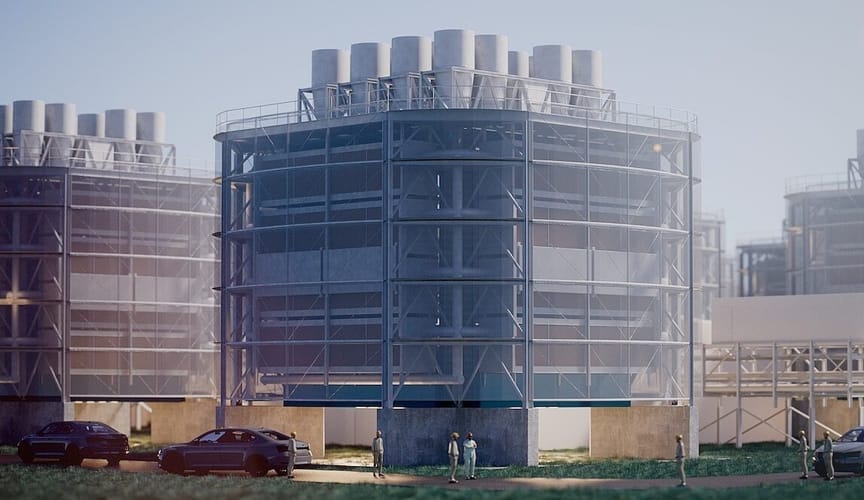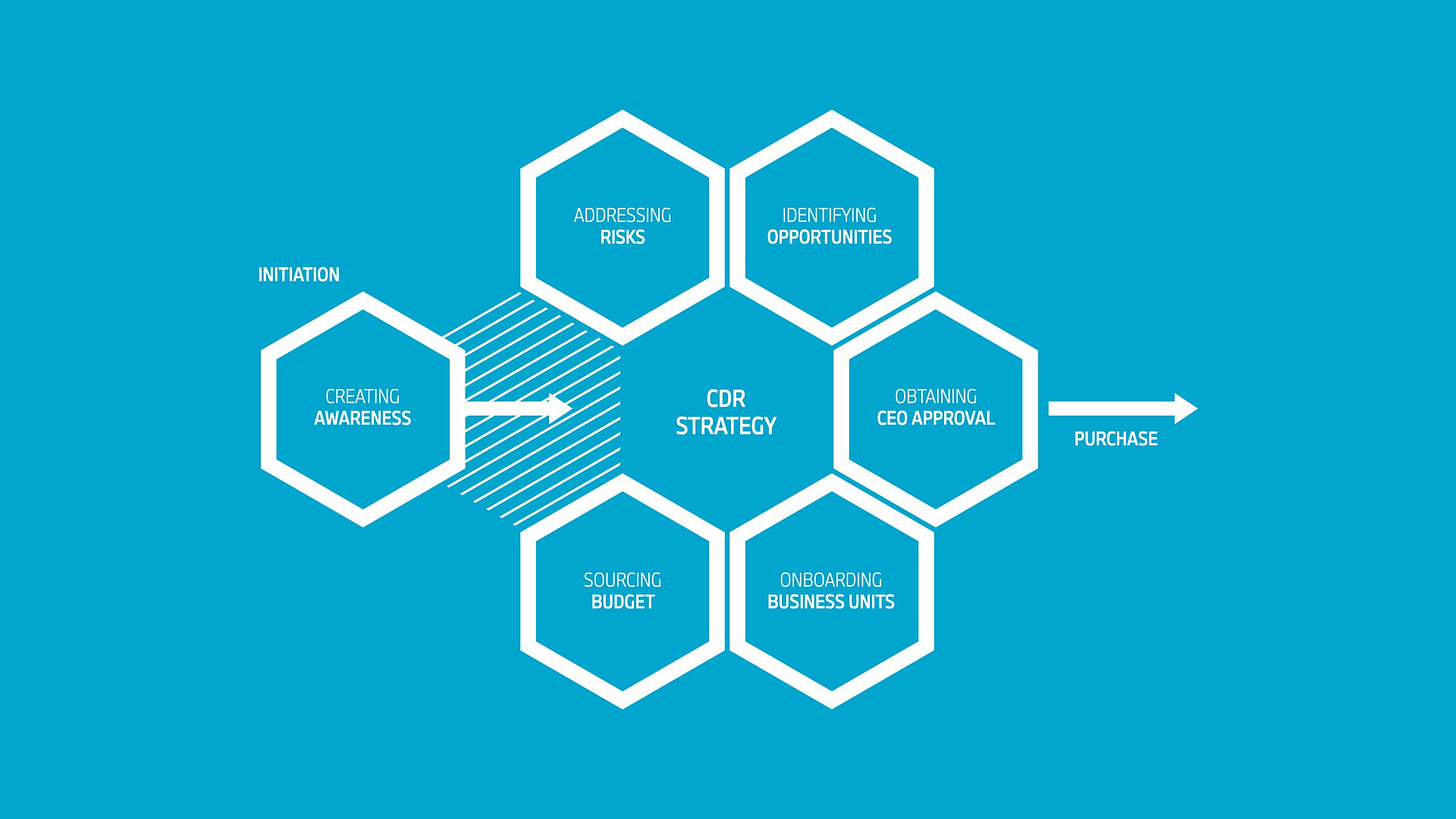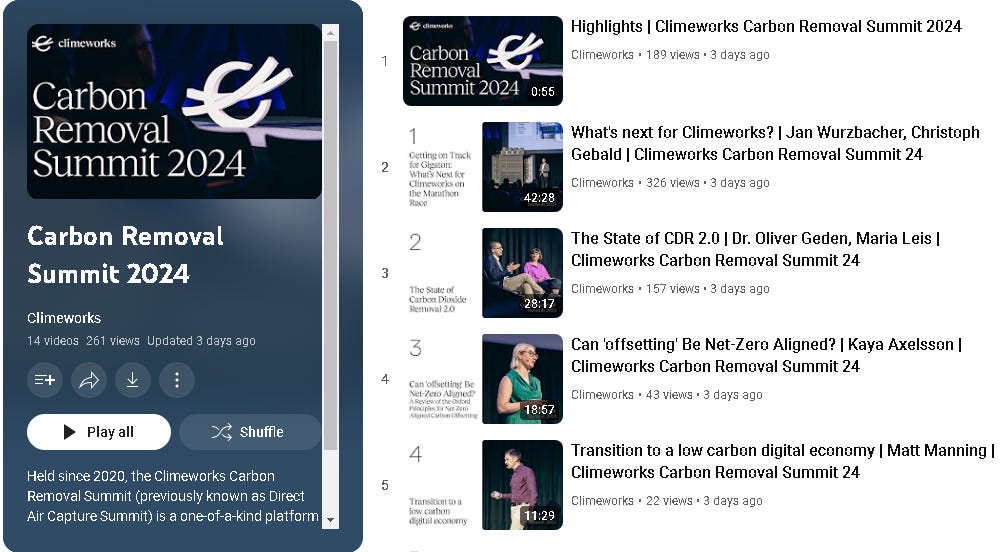CARBON REMOVAL WEEKLY SUMMARY (03 JUNE - 09 JUNE 2024)-WEEK#23
Links to recent scientific papers, web posts, upcoming events, job opportunities, podcasts, and event recordings, etc. on Carbon Dioxide Removal Technology.
💸COMMERCIAL NEWS
U.S. direct air capture company CarbonCapture Inc. secures lease for world’s first DAC manufacturing facility (Global Newswire)
NOAA, DOE sign agreement to advance marine carbon dioxide removal (NOAA)
ENGIE and Catona Climate join forces to scalesupply of nature-based carbon removals (Engie)
ecoLocked raises €4M to tackle the construction industry’s carbon footprint and enable 1Gt of carbon removal by 2040 (ecoLocked)
Babbily Joins Forces With Stripe Climate to Contribute 1% of Revenue to Carbon Removal Efforts (Street Insider)
Next generation tech powers Climeworks’ megaton leap (Climeworks)
World first protocol for Ocean Alkalinity Enhancement (Isometric)
NetZero and Dutch impact investment cooperative Oikocredit announced the signing of a financial partnership to accelerate the industrial deployment of biochar in Brazil (NetZero)
The Green Samar Reforestation Project Was Launched In The Philippines (Carbon Herald)
CICE Invests in the Future of Ocean Carbon Dioxide Removal (Newswire)
Seqana Raises €2.1M in Seed Funding (Finsmes)
A new CDR firm Metalplant, a company that produces nickel by mining the soil with plants, while removing atmospheric CO2 via enhanced rock weathering has launched (LinkedIn)
Babcock & Wilcox Signs Agreement To Proceed With Work For BECCS Project In Michigan (Biomass Magazine)
Biochar developer Planboo announced that its project in Africa has become the largest one in Africa to be certified by Puro.earth (LinkedIn)
Nori, Bayer have added 125,000 soil carbon credits (High Plains Journal)
Black & Veatch IgniteX Carbon Dioxide Removal Accelerator Program Selects 6 Startups (Morningstar)
📝RESEARCH PAPERS
Limited understanding of basic ocean processes is hindering progress in marine carbon dioxide removal
Boyd, P. W., Gattuso, J. P., Hurd, C. L., & Williamson, P. (2024). Limited understanding of basic ocean processes is hindering progress in marine carbon dioxide removal. Environmental Research Letters, 19(6), 061002.
Synopsis: Researchers review the climatic effectiveness of four nature-based techniques: shellfish cultivation, seaweed farming, coastal blue carbon restoration (including seagrass, saltmarsh, and mangrove forests), and increasing whale populations through ‘rewilding’. They conclude that while these activities offer significant non-climatic benefits, they cannot provide substantial contributions to CDR and may be ‘dead ends’ for meaningful climate mitigation.
Ocean alkalinity enhancement using sodium carbonate salts does not lead to measurable changes in Fe dynamics in a mesocosm experiment
González-Santana, D., Segovia, M., González-Dávila, M., Ramírez, L., González, A. G., Pozzo-Pirotta, L. J., ... & Santana-Casiano, J. M. (2024). Ocean alkalinity enhancement using sodium carbonate salts does not lead to measurable changes in Fe dynamics in a mesocosm experiment. Biogeosciences, 21(11), 2705-2715.
Synopsis: Artificial ocean alkalinity enhancement (OAE) modifies seawater pH and buffering capacity, impacting marine organisms and trace metal speciation. Mesocosm experiment in Gran Canaria revealed no significant iron concentration changes due to OAE, with variations likely masked by biological interactions. Results suggest OAE introduction didn't affect iron dynamics or phytoplankton.
Reduced rainfall over the Amazon basin in an idealized CO2 removal scenario: Remote dynamic processes
Zhang, S., Qu, X., Huang, G., & Hu, P. (2024). Reduced rainfall over the Amazon basin in an idealized CO2 removal scenario: Remote dynamic processes. Journal of Environmental Sciences.
Synopsis: The Amazon basin is vital for biodiversity & carbon storage, but faces decreased rainfall with global warming. Carbon dioxide removal (CDR) alone won't restore rainfall levels. Enhanced El Niño-like warming weakens zonal & meridional circulation, keeping the Amazon susceptible to drought. Local climate adaptation is crucial.
Assessment of Potential and Techno-Economic Performance of Solid Sorbent Direct Air Capture with CO2 Storage in Europe
Terlouw, T., Pokras, D., Becattini, V., & Mazzotti, M. (2024). Assessment of Potential and Techno-Economic Performance of Solid Sorbent Direct Air Capture with CO2 Storage in Europe. Environmental Science & Technology.
Synopsis: DACCS shows promise for carbon removal but faces upscaling challenges. This geospatial analysis in Europe evaluates CDR costs and potential, driven by energy availability, climate, electricity price, and CO2 transport distance. Sweden could offset 10% of emissions with waste heat. Effective DACCS implementation requires comprehensive assessments considering transport and storage. Regional differences underscore the need for location-specific analysis.
Reducing sectoral hard-to-abate emissions to limit reliance on carbon dioxide removal
Edelenbosch, O. Y., Hof, A. F., van den Berg, M., de Boer, H. S., Chen, H. H., Daioglou, V., ... & van Vuuren, D. P. (2024). Reducing sectoral hard-to-abate emissions to limit reliance on carbon dioxide removal. Nature Climate Change, 1-8.
Synopsis: To achieve net-zero greenhouse gas targets, carbon dioxide removal (CDR) technologies are essential but come with risks. Scenarios for the 1.5°C target show that demand and technological interventions can lower emissions in hard-to-abate sectors and reduce reliance on CDR. Dietary changes are crucial for cutting agricultural emissions.
Deployment of carbon removal technologies could reduce the rapid and potentially disruptive pace of decarbonization in South Africa’s climate ambitions
Afrane, S., Ampah, J. D., Jinjuan, Z., Yang, P., Chen, J., & Mao, G. (2024). Deployment of carbon removal technologies could reduce the rapid and potentially disruptive pace of decarbonization in South Africa’s climate ambitions. Journal of Cleaner Production, 142753.
Synopsis: South Africa seeks to meet emission targets without disrupting its energy sector. Carbon dioxide removal (CDR) tech offers a less aggressive path. Integrated assessment shows CDR could cut mitigation costs, ease renewable energy expansion, and prevent asset stranding. However, it may lead to higher residual emissions. Balancing decarbonization efforts with CDR investment is crucial for achieving net-zero goals efficiently.
Additive effects of basalt enhanced weathering and biochar co-application on carbon sequestration, soil nutrient status and plant performance in a mesocosm experiment
Honvault, N., Tiouchichine, M. L., Sauze, J., Piel, C., Landais, D., Devidal, S., ... & Milcu, A. (2024). Additive effects of basalt enhanced weathering and biochar co-application on carbon sequestration, soil nutrient status and plant performance in a mesocosm experiment. Applied Geochemistry, 106054.
Synopsis: Co-deployment of carbon removal technologies like basalt enhanced weathering and biochar holds promise for meeting climate targets. Mesocosm experiment reveals additive effects on carbon sequestration and co-benefits, supporting their combined application in carbon mitigation strategies.
Capturing carbon dioxide from air with charged-sorbents
Li, H., Zick, M. E., Trisukhon, T., Signorile, M., Liu, X., Eastmond, H., ... & Forse, A. C. (2024). Capturing carbon dioxide from air with charged-sorbents. Nature, 1-6.
Synopsis: Charged-sorbents, synthesized via a battery-like process, offer tunable structures for efficient carbon dioxide capture. These materials adsorb CO2 from ambient air, regenerate at low temperatures, and can be Joule-heated, promising a renewable-powered direct air capture process. With low-cost activated carbons, they hold potential for diverse applications beyond carbon capture.
Metrics for quantifying the efficiency of atmospheric CO2 reduction by marine carbon dioxide removal (mCDR)
Yamamoto, K., Devries, T., & Siegel, D. A. (2024). Metrics for quantifying the efficiency of atmospheric CO2 reduction by marine carbon dioxide removal (mCDR).
Synopsis: Modeling is crucial for assessing marine carbon dioxide removal (mCDR) impacts on atmospheric CO2 reduction due to the system's slow response. Using an interactive atmosphere-ocean model, researchers quantify CO2 reduction from ocean alkalinity enhancement (OAE) and direct air capture (DAC). DAC shows immediate reduction, declining to 50% in 100 years, while OAE reaches 40-90% efficiency after years to decades, varying spatially. This model aids in evaluating sequestration timescales and carbon market valuation for mCDR strategies.
Sponge iron-coupled biochar solution can achieve the synergistic augmentation of carbon sequestration, carbon sink capacity, and denitrification in ecological ditches
Jiang, B. N., Zhang, Y. Y., Wang, Y., Liu, H. Q., Zhou, Q., Yang, Y. J., ... & Song, H. L. (2024). Sponge iron-coupled biochar solution can achieve the synergistic augmentation of carbon sequestration, carbon sink capacity, and denitrification in ecological ditches. Chemical Engineering Journal, 152496.
Synopsis: Agricultural eco-ditches, potential CO2 hotspots, require immediate carbon capture tech deployment. Fe-biochar coupling enhances C sequestration, pollutant removal. Fe-OC boosts carbon burial, with unique mechanisms advancing C dynamics knowledge beyond eco-ditches.
Residual emissions and carbon removal towards Japan's net-zero goal: a multi-model analysis
Sugiyama, M., Fujimori, S., Wada, K., Kato, E., Matsuo, Y., Nishiura, O., ... & Otsuki, T. (2024). Residual emissions and carbon removal towards Japan’s net-zero goal: A multi-model analysis. Environmental Research Communications.
Synopsis: Multi-model study on Japan's net-zero by 2050 target reveals stronger strategies than previous goals. Abatement, energy efficiency, cleaner fuels crucial. New options like CDR with CCS and hydrogen crucial. Limiting CDR increases costs, demanding responsible policies for net-zero.
Simultaneous achievement of energy recovery and carbon sequestration through municipal solid waste management: A review
Salvador, R. W., & Doong, R. A. (2024). Simultaneous achievement of energy recovery and carbon sequestration through municipal solid waste management: A review. Chemosphere, 142478.
Synopsis: Efficient municipal solid waste management crucial for sustainable cities. Integrating carbon dioxide removal tech into MSW processes offers carbon sequestration opportunities. Review explores MSW utilization for CDR via landfilling, waste-to-energy, and biochar production, highlighting BECCS and direct storage as viable methods. Emphasis on life-cycle assessment for future endeavors.
Public perception of carbon dioxide removal in three Asian regions
Atris, A. M., Sugiyama, M., Chen, Y. C., Yiyi, J., & Yamaura, K. (2024). Public perception of carbon dioxide removal in three Asian regions. Sustainability Science, 1-15.
Synopsis: CDR crucial for net-zero targets, but social acceptability unclear outside North America and Europe. Survey across Japan, Taiwan, and China reveals limited public understanding and uncertain perceptions of CDR risks and benefits. Urgent need for wider public engagement on CDR for climate goals.
Artificial cellulosic leaf with adjustable enzymatic CO2 sequestration capability
Zhu, X., Du, C., Gao, B., & He, B. (2024). Artificial cellulosic leaf with adjustable enzymatic CO2 sequestration capability. Nature Communications, 15(1), 4898.
Synopsis: This study introduced EcoLeaf, an artificial leaf mimicking natural leaves, vital for our Net Zero Future. It sequesters CO2 using visible light, mimics stomata function, and has cellulose composition for ecosystem integration and natural degradation. Adaptable for diverse carbon sequestration pathways.
Influence of ocean alkalinity enhancement with olivine or steel slag on a coastal plankton community in Tasmania
Guo, J. A., Strzepek, R. F., Swadling, K. M., Townsend, A. T., & Bach, L. T. (2024). Influence of ocean alkalinity enhancement with olivine or steel slag on a coastal plankton community in Tasmania. Biogeosciences, 21(9), 2335-2354.
Synopsis: This study tested coastal plankton responses to ocean alkalinity enhancement (OAE) with olivine and steel slag as alkalinity sources. Both increased total alkalinity, with steel slag showing higher efficiency for CO2 removal. Phytoplankton and zooplankton communities were affected differently by olivine and steel slag, suggesting potential environmental impacts.
Private Landowner Willingness to Manage Their Land for Carbon Sequestration in New York State
Stedman, R. C., Armstrong, A., Walsh, K. B., & Connelly, N. (2024). Private Landowner Willingness to Manage Their Land for Carbon Sequestration in New York State. Journal of Forestry, fvae007.
Synopsis: Efforts to enhance carbon sequestration in New York State focus on afforestation and reforestation of privately owned lands. Survey of 979 landowners reveals interest in converting underutilized lands to mature forests for carbon sequestration. Key barriers include inadequate labor and financial resources, with financial incentives having a modest impact on willingness.
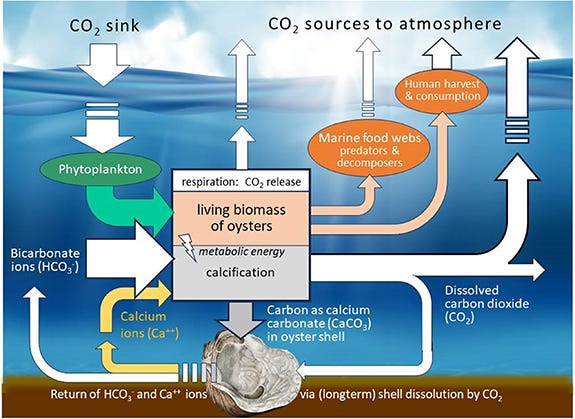

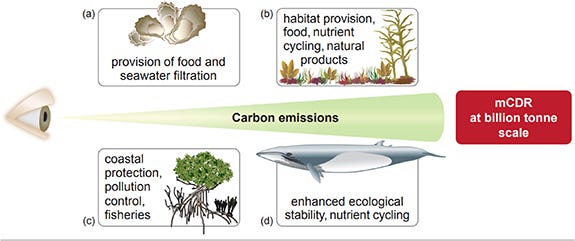

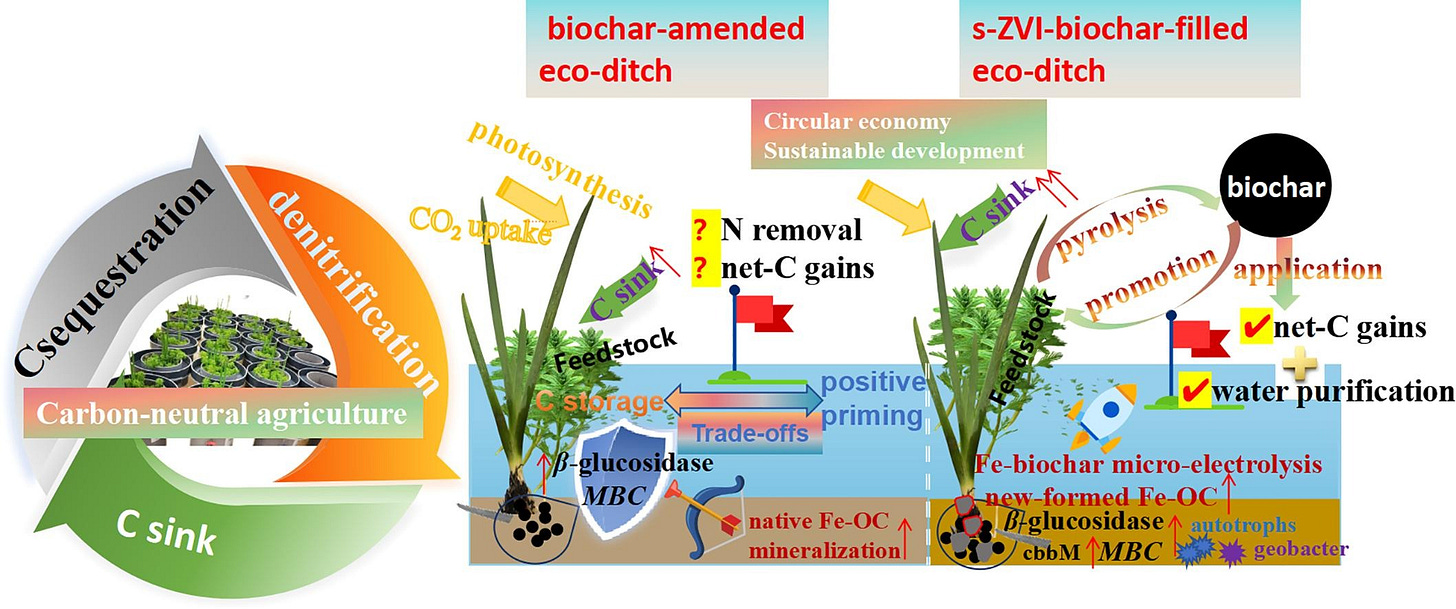
📰WEB POSTS
Nine key takeaways about the ‘state of CO2 removal’ in 2024 (Carbon Brief)
Could the Carbon Removal Industry Reach a Tipping Point that Triggers Rapid and Nonlinear Growth? (WRI)
Tech companies bet on carbon removal startups as AI tests climate goals (Yahoo!finance)
Enhanced Rock Weathering and Rock Dust Application in China (Remineralize the Earth)
CO2-removal leader Climeworks says new tech can halve costs, energy use (Canary Media)
Carbon removal needs to quadruple to meet climate goals, researchers say (Reuters)
XPRIZE Top 100 Finalists Make Up More Than Half of Deep Sky Labs (DeepSky)
How one oil producer is pursuing “net-zero” oil (cipher)
The US federal government releases Joint Policy Statement and Principles for the Voluntary Carbon Market (Carbon Direct)
Carbon Removal’s Holy Grail Cost Cut Is Further Away Than It Seems (Bloomberg)
Opinion: Nature-Based DAC Technologies Should Become The Main Force For Extracting CO2 From Air (Carbon Herald)
Supercharging Carbon Removal from the EU’s Land Sector (Inside Climate Policy)
Seas of change: Scaling up CO2 removal using the oceans a crucial part of addressing the effects of climate change (McMaster University)
Meet the 2024 Technology Pioneers of the World Economic Forum (World Economic Forum)
“We Have The dMRV Platform To Help Project Developers Prove The True Impact Of Their Biochar Project,” Clément Gourrierec, Director Crystal Trade (Carbon Herald)
How carbon removals enable CCS business cases in the United States today (Aker Carbon Capture)
The Rise of Biochar: A Sustainable Solution for Soil Health and Carbon Sequestration (Biochar Today)
Relying on soil-based carbon capture to offset livestock emissions is risky (Zero Carbon Analytics)
Climeworks Carbon Removal Summit spotlights innovation and collaboration for the race to zero (Climeworks)
Markets are more important for novel than conventional CDR (Marginal Carbon)
What Is the Opposite of Oil Drilling? (The New Yorker)
BeZero Carbon Launches Innovative Regenerative Agriculture Credit System (Carbon Herald)
SEB invites companies to buy carbon removals from waste incineration (SEB)
CarbonCure Launches in Emirates—The Halifax cleantech company raised US$80M last year (Entrevestor)
What is ‘nature-based carbon removal’ and is it any better than carbon offsets? (The Verge)

📒THESIS
An experimental analysis of enhanced rock weathering with Costa Rican basaltic powders
📃REPORTS
From Awareness to Action: The Six Building Blocks for Purchasing Carbon Removal
Biomass To Biochar For Farm Bioeconomy
Developing CDR at scale and speed in Norway
2024 State of the Voluntary Carbon Market
The State of Carbon Dioxide Removal — Edition 2
Bridging the CDR Financing Gap - The Comprehensive Guide
🗓️UPCOMING EVENTS
(NEW) CDR Swiss Webinar by Carbon Gap & DVNE | 11 June 2024 | Online
(NEW) Carbon Forward North America 2024 | 11-12 June 2024 | Toronto
(NEW) Navigating Net Zero: Residual Emissions in National Climate Strategies by Institute for Responsible Carbon Removal | 12 June 2024 | Online
Navigating Net Zero: Residual Emissions in National Climate Strategies by Institute for Responsible Carbon Removal | 12 June 2024 | Online
Workshop With A Focus on Biochar by CSINK | 12 June 2024 | Portugal
Carbonfuture Carbon Removal Summit 2024 by Carbonfuture | 13 June 2024
(NEW) Engineered carbon dioxide removal technologies - The role of DAC to scale up CO2 removal capacity by S&P Global | 13 June 2024 | Online
(NEW) Procurement Toolbox: Live Discussion and Q&A by Carbon180 | 13 June 2024 | Online
Carbon Catch-up: Navigating Decarbonization in Aviation with Carbon Removal Solutions by Climeworks | 13 June 2024 | Online
Future-proof carbon removal strategies that make an impact by Carbon Direct | 13 June 2024 | Online
(NEW) BioChar in Circular Economy by Climate Change Professional Association | 14-15 June 2024 | London
(NEW) Climate Interventions: Carbon Removal at Scale by The Institute for Science & Policy In partnership with The Institute for Responsible Carbon Removal | 17 June 2024 | Colorado & Online
Biorefining and Biomanufacturing: Towards net negative carbon systems by Tech Connect | 17-19 June 2024 | Washington, DC
EU Carbon Removal Certification – Biochar Methodology | 18 June 2024 | Online
Listening Session on Two Tentative MPRSA Research Permits: Woods Hole Oceanographic Institution LOC-NESS Project by US EPA | 18 June 2024 | Online
Methodologies: Major Revision Toward VM0042, v3.0 by VEERA | 18 June 2024 | Online
Negative CO₂ Emissions hosted at the University of Oxford by CO₂RE - The Greenhouse Gas Removal Hub, with financial support from UKRI | 18-21 June 2024
(NEW) European Biochar Certification C-Sink Standard by European Biochar Industry Consortium (EBI) | 19 June 2024 | Online
(NEW) WORKSHOP: Economic opportunities from carbon crediting for BECCS projects in Norway | 19 June 2024 | Oslo
Goodbye Greenhouse Gas @ The Old Fire Station by CO2RE | 20 June 2024
Negative Emissions Summit 2024 | 20 June 2024
(NEW) Mining the Atmosphere» – CO 2 from the atmosphere as a raw material for new materials | 26 June 2024 | Empa, Dübendorf
Carbon Capture Technology Expo North America | 26-27 June 2024
The Regenerative Agriculture Festival by Groundswell | 26 &27 June 2024 | UK
(NEW) Carbon removal procurement playbook with U.S. Department of Energy (DOE), Bain & Company, and Charm Industrial by Patch | 27 June 2024 | Online
From Here To Where? Developing The CDR Legal Landscape In The EU by CSink | 28 June 2024 | Online
Driving Development of Ocean-Based Carbon Removal Technologies with Innovations in MRV, Oceanographic Modelling & New Policy Frameworks to Reduce Global CO2 Emissions | 9-11 July 2024
Advancing Carbon Management: Insights from Land to Sea Using ArcGIS Tools | 16 July 2024 | San Diego / Online
2nd Biochar Malaysia Association International Conference 2024 by International Biochar Initiative | August 13-14, 2024
Goldschmidt 2024 conference, Chicago | 18-23 August 2024
Carbon Unbound Europe | 11-12 September 2024
Carbfix Mineralization Summit 2024 | 12-13 September 2024
Grounding Carbon Farming at Wageningen University & Research by WIMEK in collaboration with SBL, ENP, NGO myclimate, and the farm "La ferme de Hyaumet" | 14-20 September 2024 | France
Bellona Climate Action Conference | 01 October 2024 | Brussels (Belgium)
(NEW) Volcanoes and past climate: adventures with deep carbon | 12 October 2024 | Online & ExCeL London
IBI Biochar Study Tour: Italy by the Italian Biochar Association and the International Biochar Initiative | 16-18 October 2024 | Florence, Italy
How to apply biochar in sustainability management and accounting | German Biochar Forum | 18 November 2024
We have curated a “Carbon Removal Events Calendar.” Explore and stay informed about upcoming events, conferences, and webinars on Carbon Dioxide Removal technology. Sync specific events / all events to your default calendar to ensure you never miss out on important CDR updates.
GUIDELINES:
Sync selected events to your default calendar in these simple steps:
1) Click on the event you want to sync.
2) Tap the menu icon (three vertical lines) at the top left.
3) Choose 'Share.'
4) Pick your default calendar.
5) Save the event.
Sync the entire Teamup Calendar to your default calendar with these simple steps:
1) Tap the menu icon (three vertical lines) at the top right.
2) Choose 'Preferences.'
3) Click 'iCalendar Feeds.'
4) Copy the URL shown for 'CDR Events / CDR General Guidelines / CDR Job Deadlines.'’
5) Paste the URL into your default calendar settings.
6) Click 'Subscribe' or 'Add Calendar.'
For more detailed instructions, visit: https://calendar.teamup.com/kb/subscribe-to-teamup-icalendar-feeds/
You can directly sync all Carbon Removal events to your default calendars by pressing the link below:
💼JOB OPPORTUNITIES
Molecular Biologist at CyanoCapture | Oxford, England, United Kingdom | Deadline: 21 June 2024
"CyanoCapture is a VC-backed biotech company from the University of Oxford, using the forefront of bioengineering for carbon capture. The company is using a recently discovered fast-growing photosynthetic bacteria that can rapidly absorb CO2 and convert this into organic compounds of interest. CyanoCapture is looking to scale-up its proof-of-concept work to pilot trials in the UK, United Arab Emirates and Portugal in 2025. The first-of-a-kind technology has been backed by Shell, Elon Musk's XPRIZE and Innovate UK, alongside a number of VCs and private investors."
Manager of People Operations at Living Carbon | San Francisco Bay Area
"Living Carbon’s mission is to responsibly rebalance the planet’s carbon cycle using the power of plants."
Senior Hardware Engineer at Yard Stick | Oakland, CA
"Yard Stick is a remote-first climate tech startup with cofounders based in Boston, MA and Oakland, CA. We are on a mission to reverse climate change with agriculture. Scientists and farmers alike know that climate-friendly agricultural practices have the potential to remove atmospheric CO2 at gigaton/year scale. When these practices are adopted, more carbon is stored in soils, improving soil health and fighting climate change. But significant measurement challenges have held soil carbon efforts back - until now."
Director, Carbon Markets at CarbonCure Technologies | United States
"CarbonCure Technologies is on a mission to makeconcretea climate solution, reducingembodied carbonemissions in the built environment and transforming concrete plants into a worldwide network of carbon removal factories."
Head of Legal, Risk and Complianceat BeZero Carbon | London, United Kingdom
"BeZero Carbon is a global ratings agency for the Voluntary Carbon Market. We distribute our ratings via our SaaS Product, BeZero Carbon Markets, informing all market participants on how to price and manage risk. Our ratings and research tools support buyers, intermediaries, investors and carbon project developers."
Product Marketing Manager at Ebb Carbon | San Francisco, CA, USA
"Ebb Carbon is a team of leading scientists, oceanographers, chemists, engineers, communicators and more who have decades of experience developing and scaling solutions to climate change. Together we are working on removing billions of tonnes of excess carbon dioxide already in the air due to human-generated CO2 pollution over the last 200 years. Ebb's approach to removing CO2 from the air is unique because we enhance the ocean's natural ability to capture and store carbon. In the process, we also locally reduce the acidity of seawater. Our electrochemical technology has the potential to be one of the largest scale and lowest cost approaches to removing excess CO2 from the air."
Ecologist at TASC (The African Stove Company) | Cape Town, Western Cape, South Africa
"TASC is looking for a dedicated and knowledgeable Ecologist to join their Carbon projects development team. The successful candidate will be responsible for contributing to project proposals, assessing new nature-based solutions for ecological integrity and function, identifying risks, making recommendations for project implementation, and contributing to feasibility assessments. The candidate will also be involved in assisting with biogeochemical modelling for different nature-based projects. This role offers a unique opportunity to apply ecological expertise towards the development of carbon projects, contributing to both environmental conservation and climate change mitigation."
Director, Blue Carbon Positive Business Models at Conservation International | Remote
"Conservation International (CI) and our partners are pioneering a new initiative to save our coastal ecosystems while driving economic growth by establishing a Blue Carbon Positive Business Model Activator (BC+). BC+ goes beyond traditional carbon credits, focusing on sustainable, economically viable business models with broad applicability that benefit both the environment and the people who depend on it. By creating regenerative blue carbon businesses, BC+ aims to provide local incentives through economic growth and coastal protection, promoting a transition to a more sustainable and prosperous future where nature and humanity thrive together."
Electrical Engineering Lead - Carbon Capture Project at Heidelberg Materials | Allentown, PA, USA
Heidelberg Materials is developing USA’s first full-scale carbon capture, utilization, and storage (CCUS) solution for the cement industry at its Mitchell plant, Indiana that has potential to capture up to 2 million metric tons per annum of carbon dioxide (CO 2 ) and transported by pipeline, and permanently sequestered in deep saline storage formations by 2030. This project will be a critical to achieve the sustainability targets set forth in decarbonisation road map, that will allow Heidelberg Materials and our customers to reduce emissions in the built environment and support near carbon-neutral concrete offerings.
Manager, Carbon Market Analysis at ClearBlue Markets | Toronto, Ontario, Canada
"ClearBlue Markets is seeking a talented and driven Manager, Voluntary Carbon Markets to join our Market Analysis team in Toronto. Our ideal candidate will take ownership of our VCM work and act as the expert on VCM, encompassing a comprehensive understanding of policy development, market trends, specific project types such as Nature-Based Solutions (NBS) and Carbon Dioxide Removal (CDR), and regional market dynamics. The role involves translating this expertise into actionable insights and accurate forecasts, ensuring that ClearBlue's clients and internal teams are well-informed and strategically positioned. The Manager will be required to coordinate with various departments to maintain consistency in analysis and strategy across the organization."
Hydrological Modeling Development Intern at Everest Carbon | India
"Everest Carbon is commercializing breakthrough proprietary measurement technology to validate carbon dioxide removal (CDR) through enhanced weathering (EW)."
Postdoctoral Research Scholar - Carbon Sequestration Accounting at Arizona State University: Office of the University Provost Tempe: College of Global Futures: School of Complex Adaptive Systems
The Center for Negative Carbon Emissions (CNCE) at Arizona State University is seeking a highly skilled and motivated postdoctoral research scholar to assist CNCE researchers in assessing the verifiability of carbon sequestration technologies across geologic and oceanic reservoirs.
This position will work with an interdisciplinary team of physicists, geologists, engineers, oceanographers, modelers, and climate scientists, with funding from the Department of Energy (DOE) and the Advanced Research Projects Agency–Energy (ARPA-E) and Office of Fossil Energy and Carbon Management (FECM).
Specifically, the postdoctoral researcher will be responsible for supporting the assessment of the verifiability of sequestration in two different types of reservoirs: (1) ocean iron fertilization in open waters of the United States maritime zone and (2) sequestration in a saline aquifer in the Southwest United States and. This effort will advance a novel carbon accounting framework designed to verify the sequestration of carbon. Most of the focus will be on marine sequestration in the early phases of the postdoc position.
🎙️PODCASTS
Ryan Pollyea talks about geologic carbon sequestration | Curious Conversation
"Ryan Pollyea joined Virginia Tech’s “Curious Conversations” to talk about geologic carbon sequestration, which is the process of permanently storing carbon dioxide thousands of feet below the Earth’s surface. Pollyea explained what types of rock this is currently known to work with, the efforts he and his colleagues are taking to expand this to other geologic regions, and the potential impact that could have for the environment and economics."
Episode 5: 'The End of the Beginning' | Grounded: A Climate Startup Journey
"It’s the fifth and (for now) final episode, and Tom finds himself facing the challenge that all founders will face: how to make the numbers work. So he whips out his calculator, picks up the phone, and starts sending off those grant applications. Amidst it all, he’s dealing with a cold workspace, grappling with contracts, and taking his first foray into filmmaking. Sure, he’s picked up a few new skills lately. But the question is: can he find a buyer for his credits? And, ultimately, will he get the funds he needs to make this all happen?
Grounded is the story of a startup that wants to remove carbon from the atmosphere and help reshape our relationship with the planet. Ideally without burning to the ground in the process."
Farm-Fresh Cornish Carbon Removals | Wicked Problems
"In this episode, host Richard Delevan talks with Tom Previte, founder of Restord, a biochar carbon removal startup. Tom shares his journey from the tech startup world to climate impact, highlighting the critical need for carbon removal, the challenges of scaling biochar technology, and his unique connection to Cornwall, UK. They delve into the complexities of funding climate tech startups and the importance of making tangible impacts in the carbon removal industry."
Carbon Removal & the Philosophy of Science: Kuhn's Paradigms & Feyerabend's Anarchism—w/ Anu Khan & Dr. Holly Jean Buck | Reversing Climate Change
"How do we conduct science when there isn't a single isolated variable? What does that mean for carbon removal not taking place in a controlled environment? How does science even work?!
Today's show originated from a question of how open-system carbon removal research can be conducted given that in a less-controlled environment, isolating for a single variable with replicability is less obviously possible. Does the scientific method really demand that, or is that some sort of pop culture understanding of science that needs to be challenged?
To answer that question, host and co-founder of the Nori carbon removal marketplace, Ross Kenyon, asked Dr. Holly Jean Buck of the University at Buffalo and Anu Khan of Carbon180, to read two books and come on Reversing Climate Change to discuss them.
The two texts are some of the foundational works of modern philosophy of science: Thomas Kuhn's The Structure of Scientific Revolutions, and Paul Feyerabend's Against Method.
Kuhn argued that paradigms are the collection of foundational beliefs we have about how science and knowledge production is conducted, and that they are quite hard to see outside of since most people work so deeply within them. It can often be a generational effort, as older scientists die and new ones take their places.
Feyerabend goes further, arguing that we shouldn't just look for where one paradigm supersedes another, but be protective of competing systems of knowledge and the valuable ways of seeing that they unlock.
The show applies their learnings to the state of the CDR industry, and attempts to ferret out carbon removal's existing paradigm, whether the world is ready for credits that are not tonne-denominated, and how much time we can afford in retooling and letting "normal science" work within an imperfect paradigm vs. trying to create an entirely new paradigm ex nihilo."
"Carbon removal can help local communities," Noah Deich, Senior Advisor at the U.S. Department of Energy | Carbonsations
"Joining us for this episode is Noah Deich, a Senior Advisor at the U.S. Department of Energy's Office of Fossil Energy and Carbon Management (FECM). Noah shares his journey from co-founding the climate NGO Carbon180 to his current role at the DOE and delves into the FECM's initiatives to support carbon removal, including the Carbon Negative Shot and the Voluntary Carbon Dioxide Removal Purchase Challenge."
Voluntary Carbon Markets, Investing in 100+ CDR Startups, Hard-to-Abate Sectors, & More w/ Marian Krueger (remove) | CleanTechies
"Marian Krueger comes to us with his experience investing in 120+ early stage CDR startups, and broke down what we should look for and what’s worth watching in the years ahead.He’s a leading expert in CDR having invested in Europe, which is the leading CDR ecosystem in the world.Sitting down with him as a blast."
🎥YOUTUBE VIDEOS
How Big Tech is using rocks to reach net zero and combat climate change | Yahoo Finance
"As the world’s largest companies scramble to tackle the impacts of climate change, Big Tech is betting on a surprisingly low-tech solution to reach their net-zero goal. Enhanced rock weathering already happens naturally over thousands of years, but startup Lithos Carbon is accelerating the process, spreading leftover rock dust across farm fields.
The company is scaling its operation with financial backing from Frontier, a consortium of investors that include Meta (META), Alphabet (GOOG, GOOGL), and JPMorgan (JPM). The climate fund, led by payments processing company Stripe, committed $57.1 million to Lithos Carbon last year to remove over 154,000 tons of carbon.
Lithos Carbon is one of hundreds of startups globally that are competing in a carbon removal industry expected to reach $135 billion by 2040, according to consulting firm BCG.
Once considered a workaround for critical emission-cutting work, carbon removal technologies, which extract and sequester carbon dioxide emissions from the atmosphere, are increasingly seen as a necessary step to capping global warming at 1.5 degrees Celsius by 2050, as laid out in the Paris Agreement."
Carbon removal can help local communities," Noah Deich, Senior Advisor at the US DOE | Carbon Herald
"Joining us for this episode is Noah Deich, Senior Advisor at the U.S. Department of Energy's Office of Fossil Energy and Carbon Management (FECM). Noah shares his journey from co-founding the climate NGO Carbon180 to his current role at the DOE and delves into the FECM's initiatives to support carbon removal, including the Carbon Negative Shot and the Voluntary Carbon Dioxide Removal Purchase Challenge."
The State of Carbon Dioxide Removal Report - 2nd edition | OxfordSmithSchool
"Join us at the launch of the eagerly anticipated new edition of The State of Carbon Dioxide Removal – the independent, scientific assessment tracking the development of Carbon Dioxide Removal (CDR) globally.
With updated data, expanded global coverage and a new chapter on Monitoring, Reporting and Verification (MRV), ear authors present the latest findings from the report and ask your questions on CDR development and progress. After short presentations, the authors will be joined by expert contributors and will answer audience Q&A."
What would it take to remove 600,000 tons by December 31st? | Tito - AirMiners
Carbon Removal Summit 2024 | Climeworks
"2023 was the hottest year on record and 2024 will likely increase the global average temperature even more. On top of deep and rapid emission cuts, carbon removal is indispensable to reach global climate targets. At the fifth edition of the Climeworks Carbon Removal Summit, formerly known as the Direct Air Capture Summit, the industry’s foremost experts explored what it takes to gain speed in the marathon race to net zero."
Sustainable Futures: Carbon Removal with Smallholder Farmers (webinar) | Biochar Life
Exploring Ocean Alkalinity Enhancement with Vycarb's CEO Garrett Boudinot | Bite-Size Climate Tech
"I talked to Garrett Boudinot, CEO of Vycarb, to discuss their innovative approach to ocean alkalinity enhancement (OAE). Vycarb is pioneering modular, autonomous systems that measure and sequester carbon dioxide in coastal waters, which contain higher CO₂ levels than other parts of the ocean. Garrett explains how their technology works, the ecological benefits of reducing ocean acidification, and the importance of OAE in combating climate change."
Weekly Carbon Removal Updates from 03 June - 09 June 2024 | Carbon Removal Updates
🚨DEADLINES
Equatic.tech published Standard-Setting Methodology for CDR Verification with EcoEngineers & the International Organization for Standardization | It is now open for public consultation until 10 June 2024
Request For Proposals—NextGen CDR’s 2024 Procurement Round is open for applications | RFP applications due by 14 June 2024
The Ocean Alkalinity Enhancement Pelagic Impact Intercomparison Project (OAEPIIP) is providing funding (~$12000) for a standardized OAE experiment with microcosms | Deadline to apply: 15 June 2024
The 3rd International Conference on Negative CO₂ Emissions will be hosted at the University of Oxford by CO₂RE - The Greenhouse Gas Removal Hub, with financial support from UKRI | 18 - 21 June 2024
Request For Information on The Development of an Environmental Impact Assessment Framework for Marine Carbon Dioxide Removal | Submit Feedback by 21 June 2024
Carbon2Value's Initiative is now accepting applications for its 4th Cohort | Deadline: 21 June 2024
Request For Information on The Development of an Environmental Impact Assessment Framework for Marine Carbon Dioxide Removal | Deadline to submit feedback by 21 June 2024
(NEW) 2024 CDR Salary Survey | Deadline to fill survey: 23 June 2024
"CDR is a brand-new industry. We have the opportunity to develop it in a fair, equitable, and accessible way from the start. This requires us knowing the status quo. For this reason, CDRjobs launched the 2024 CDR Salary Survey: whether you are already working or looking to work in CDR, take part in this anonymous, 3 minute survey to help us create salary transparency. Over 300 people have already taken the survey and it will remain open until June 23rd and insights will be released as a report in July."







